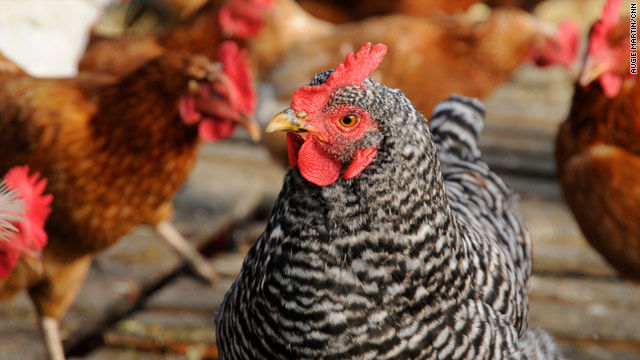博文
美国CNN: 先有鸡还是先有蛋?或许是鸡
|||
千古之谜: 先有鸡还是先有蛋?
美国有线电视新闻网(CNN)
英国研究者解决了有关鸡与蛋这一古老难题。但他们对不对呢?
根据最近发表的一篇科学论文,《蛋壳蛋白晶核结构控制》(Structural Control of Crystal Nuclei by an Eggshell Protein),媒体就以头条新闻宣布:答案是——鸡!
但是,该论文的主要作者——来自英格兰北部谢菲尔德大学(Sheffield university)科林.弗里曼(Colin Freeman)告诉美国有线新闻网,结果似乎还不能最后定论。
“我认为,蛋壳概念在鸡之前,它是恐龙、甚至恐龙之前的事情。这是可向进化生物学家讨论的一个可能。”科林说。
因此,关于“晶核”的论文怎么能成为鸡先于蛋的证明呢?
……

[CNN的英文报道附后】
————————————————
确实如此,因为2008年就有相关报道《先有鸡还是先有蛋?加拿大科学家揭谜底》,说是先有蛋。新闻如下:http://tech.qq.com/a/20081118/000066.htm
腾讯科技讯 据美国生活科学网报道,鸡和蛋先后之争持续已久,究竟是先有的鸡还是先有的蛋,这一让人百思不得其解的古老谜题终于有了谜底。通过对7700万年前的恐龙蛋化石的研究后,科学家宣布谜题答案是先有的蛋后有的鸡。……
——————————
究竟是先有鸡还是先有蛋,等一段时间或许有结论。
但愿英国研究人员的先有鸡是正确的。
Scientists solve chicken and egg riddle*
Editor's Note: *Maybe
London, England (CNN) -- Researchers in Britain have been credited with cracking the age-old conundrum about the chicken and the egg. But are they right?
After the publication of the rather dry-sounding scientific paper, "Structural Control of Crystal Nuclei by an Eggshell Protein," press headlines proclaimed the answer was... the chicken.
However, one of the paper's lead authors, Colin Freeman, from the University of Sheffield in northern England, told CNN that the result was not as conclusive as it seemed.
"I would argue that the concept of an eggshell came about way before the chicken, it's dinosaur or even pre-dinosaur thing. That's something to talk to an evolutionary biologist about probably," he said.
So how did a paper about "crystal nuclei" become proof that the chicken pre-dated the egg?
Freeman and his team, which included colleagues from the University of Warwick, were researching a protein found in eggshells called ovocledidin-17. It is also found in chickens' ovaries, but until the team's research its purpose was not clear.
Using Britain's national supercomputer, a machine dubbed HECToR based in Edinburgh, Scotland, they were able to simulate the process of biomineralization, or the production of minerals or solid materials inside organisms.
It was a world first and revealed that one potential purpose of the protein ovocledidin-17 is to speed up the production of eggshell within the chicken so that in 24 hours an egg is ready to be laid.
"What we have really identified is that the protein seems to accelerate the crystallization process so it can make that eggshell appear far quicker. In simple terms it accelerates calcite formation," Freeman said.
They also found that the egg can't be produced without the protein ovocledidin-17 in the chickens' ovaries, so that means that the chicken must have come first. Right?
"Obviously, it's not really what we were trying to get out of our simulations, but it's an interesting question isn't it?" Freeman said.
Rather than putting an end to bickering over the true order of the egg, the researchers were trying to understand more about how shell is formed so that they can apply their findings in other disciplines, including medicine.
"The quote my colleague John Harding always says is, 'could we ever be as clever as algae?'" Freeman said.
"They produce these wonderful shells that protect them in the North Sea. That crystal structure is far in advance of anything that we as humans can create in the lab," Freeman said, adding, "We can't make a human skeleton in the lab..."
Perhaps one day they will be able to. And perhaps one day someone will conclusively put an end to the argument -- was it the chicken or the egg?
Have Scientists Solved Chicken vs. Egg Debate?
Posted on: Thursday, 15 July 2010, 06:35 CDT
Which came first: the chicken or the egg? It is an age old question that has spurred on many a debate, but now a group of scientists might actually be close to having an answer.
Using cutting-edge technology, researchers from the Universities of Sheffield and Warwick in
Scientists had long theorized that a chicken protein known as ovocledidin-17 (OC-17) played a crucial role in the formation of an egg's shell, but thanks to a new computer simulation, they were able to demonstrate the actual process.
According to a joint press release issued by both universities, "The protein is found only in the mineral region of the egg (the hard part of the shell) and lab bench results showed that it appeared to influence the transformation of (CaCo3) into calcite crystals. It remained unclear how this process could be used for forming an eggshell."
However, thanks to a new tool known as metadynamics and the assistance of the a Edinburgh-based supercomputer, "the researchers were able to create simulations that showed exactly how the protein bound to amorphous calcium carbonate surface using two clusters of 'arginine residues,' located on two loops of the protein and creating a literal chemical 'clamp' to nano sized particles of calcium carbonate… While clamped in this way, the OC-17 encourages the nanoparticles of calcium carbonate to transform into 'calcite crystallites' that form the tiny of nucleus of crystals that can continue to grow on their own," according to the July 12 press release.
However, the process was not 100-percent successful, the researchers discovered that the chemical clamp failed on occasion, as the OC-17 would just seemingly detach from the nanoparticle.
"The researchers had therefore uncovered an incredibly elegant process allowing highly efficient recycling of the OC-17 protein," claims the universities' media statement.
"Effectively it acts as a catalyst, clamping on to calcium carbonate particles to kickstart crystal formation and then dropping off when the crystal nucleus is sufficiently large to grow under its own steam. This frees up the OC-17 to promote more yet more crystallization, facilitating the speedy, literally overnight creation of an egg shell."
"Understanding how chickens make eggshells is fascinating in itself but can also give clues towards designing new materials and processes," Sheffield University Professor John Harding, one of the authors of the paper "Structural Control of Crystal Nuclei by an Eggshell Protein," said, according to a Wednesday AFP news report. "Nature has found innovative solutions that work for all kinds of problems in materials science and technology--we can learn a lot from them."
His colleague, Professor Mark Rodger of the Department of Chemistry and Centre for Scientific Computing at the
The paper entitled “Structural Control of
Image 2: Protein attached to calcium carbonate nanoparticle.
http://www.redorbit.com/news/science/1892051/have_scientists_solved_chicken_vs_egg_debate/index.html
https://wap.sciencenet.cn/blog-108262-344005.html
上一篇:[摘译]英国调查小组澄清涉嫌“气候门”的科学家
下一篇:绿色美国 绿色中国
全部作者的精选博文
全部作者的其他最新博文
全部精选博文导读
相关博文
- • Minerals线下恳谈会:履践致远、与时偕行——对话中国科学院广州地球化学研究所期刊合作学者
- • 聚英才 建高地 | 北京理工大学“特立青年学者”全球招聘开启
- • 700年后日本或濒临灭绝?日本学者推算预测:届时或仅剩1名15岁以下孩子
- • [转载]【同位素视角】非英语母语学者如何区分’e.g.’, ‘i.e.’, ‘namely’与‘such as’等混淆难题
- • 美国佐治亚大学等机构学者:刈割策略对Bulldog 805紫花苜蓿+Tifton 85狗牙根混播草地产量及品质的影响
- • 美国堪萨斯州立大学、密苏里大学等机构学者研究成果:土壤水分管理策略和品种多样性对紫花苜蓿产量、营养品质和农场盈利能力的影

